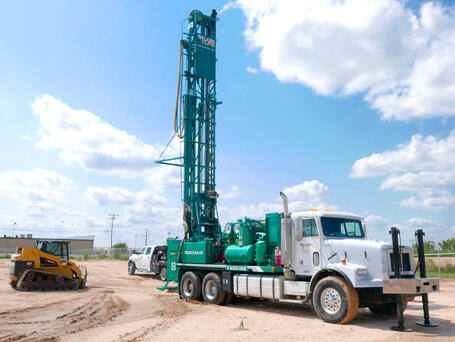Selection of a drilling method for your new project is an important decision that can affect the project outcome. Factors you may want to consider include project goals, geologic and groundwater conditions and a schedule.
Rotary and sonic drilling are the choices you will likely consider especially if you will be drilling deeper boreholes and into harder or more difficult geologic formations.
How Do Rotary And Sonic Drilling Work?
Rotary drilling advances a borehole using impact energy from an above or below ground impact hammer plus rotation to crush the formation at the drill. Formation drill cuttings are removed from the borehole with circulating compressed air or water. In unstable conditions additives like bentonite are added to water, called “mud”. Using air, cuttings are blown into a catchment and, using water or mud, funneled into a cutting settling pit. Cuttings are then recycled back into the borehole.
Sonic drilling advances a borehole using resonant high frequency vibrations to fluidize the formation at the drill bit. Vibrations created in the sonic head at the top of the drill string move rapidly up and down the drill string with intense vibration at the drill bit. Resonant frequencies of 50 to 200 Hertz, which are audible and thus “sonic,” can be controlled to suit the type of formation. Rotation can be added when drilling in harder geologic formations. Sonic drilling can be used in most geologic materials, especially for those difficult drilling conditions.
What Are Rotary Drilling Advantages And Disadvantages?
Rotary drilling is the most common method for various formation materials and geotechnical environmental oil and mining drilling projects. Air rotary is a good choice for deeper boreholes and most geologic formations; mud rotary is a better choice for unstable and unconsolidated formations. Most types of sampling, instrumentation and downhole testing can be done using rotary drilling.
One disadvantage to rotary drilling is higher costs for disposal of drilling waste, including large volumes of water if drilling below the water table. This method is not as efficient in difficult drilling conditions such as boulders, fill or landfills. Also, use of mud may affect samples for contamination. Variations of rotary drilling methods may limit some types of sampling and testing.
What Are Sonic Drilling Advantages And Disadvantages?
With sonic drilling, borehole advancement is equal to rotary. This method is some what effective in difficult drilling conditions, like gravel, boulders and fill/landfill, and softer formations, like sandstone limestone or weathered basalt. Sonic drilling produces up to 10 percent less drilling waste volume than rotary drilling. Vibration associated with sonic drilling eases casing removal for grouting projects and the use of air reduces borehole wall smearing for geotechnical and environmental sampling and downhole testing.
Drilling vibration can, however, disturb surrounding formations or cause new fractures in hard bedrock, affecting structural or aquifer testing. Sonic drilling is not cost effective for few or shallow borings, in easier drilling conditions or in hard bedrock. Drilling heat generated by this method in some geologic formations may change texture, moisture or contaminant conditions, but this side effect may be controlled using drilling fluid. Finally, generation of sonic vibrations may require more hearing protection.
On average Sonic Drilling is 3 to 5 times more expensive than Air Rotary/Mud Rotary drilling.
Contact our drilling experts to learn more about rotary and sonic drilling methods and all of our other drilling and environmental services. Talon/LPE has provided drilling services to customers in Texas, Oklahoma, New Mexico and Kansas for more than 20 years.

